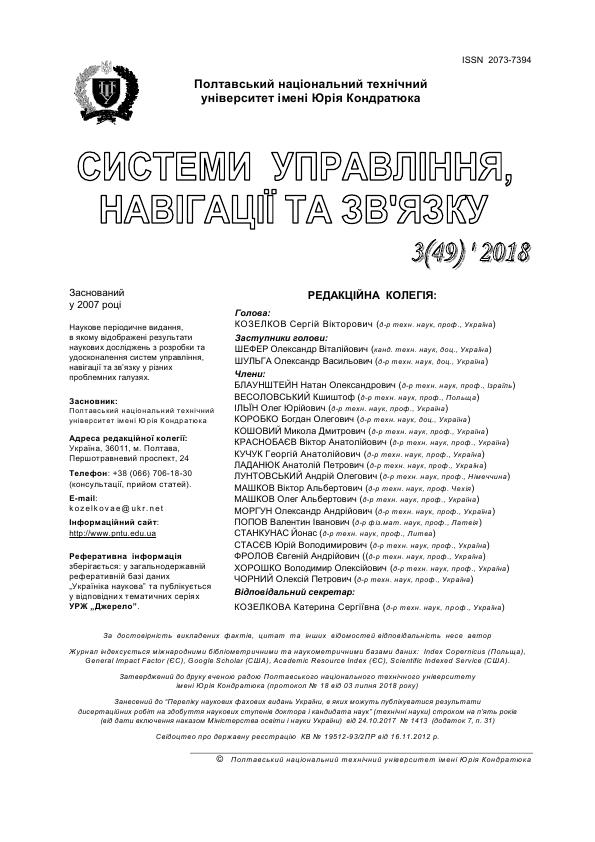THE MULTILATERY SYSTEM USE FOR INCREASING THE QUALITY OF RADAR CONTROL OF THE AIR SPACE
DOI:
https://doi.org/10.26906/SUNZ.2018.3.055Keywords:
radars, control point, MLAT, information source, air situation, dependent observation, independent observation, airspace, airspace control, coordinatesAbstract
The subject matter of the article is the multilateration system (MLAT) and interaction this system with modern radar facilities during radar control (RC) of airspace. The goal is to analyze the possibilities of the MLAT system use to improve the efficiency of the RC airspace. The tasks to analysis of the main trends in the development means of air attack, analysis of known organizational and technical ways to improve the efficiency of the RC airspace of low-visibility and small air objects, determination of directions for combining the capabilities of the MLAT system and information from radar equipment, analysis of the possibility of obtaining information from the MLAT system in radio departments, analysis of features and restrictions of using information from the MLAT system. The methods used are: methods of determining coordinates of air objects, the distance-range method, the passive radar methods, methods of determining coordinates of air objects using the information from satellite navigation systems. The following results were obtained. It is identified that the MLAT system is an independent co-operative observation system, the MLAT system is basis of the difference-distance-finding method for determining the coordinates of air objects, the minimum number of receiving points is equal to three, an expression for the linear error of the difference-distance-finding method in the MLAT system is established, it is established that the receivers in the MLAT system it is possible to use transponders ADS-B system, there are several variants of the decision to provide for detection of potentially dangerous air objects which wish to be unnoticed, or carry out "mimicry". Conclusions. The scientific novelty of the results obtained is as follows: to increase the accuracy of the determination of the coordinates of the air objects and the quality of RC of the airspace by combining the capabilities of the MLAT system and the information from the existing radar equipment; found that the MLAT system will use significantly increase the accuracy of air objects tracking; the ways of optimization of geometric construction of receivers of the MLAT system at the positions of the radio units and the development of method for the joint processing of radar information and information from the MLAT system at the RC of the airspace were determined.Downloads
References
Артеменко А. М., Пєвцов Г. В. Тенденції розвитку Повітряних Сил Збройних Сил України на основі аналізу досвіду проведення АТО. Новітні технології — для захисту повітряного простору: Тези допов. 11 наук. конф. Харк. ун-ту Повітряних Сил ім. Івана Кожедуба (Харків 8–9 квіт. 2015). Х.: ХУПС, 2015. – С. 16.
Савин Л. В. Сетецентрическая и сетевая война. Введение в концепцию. М.: Евразийское движение, 2011. – C. 130.
Довідник учасника АТО: озброєння і військова техніка Збройних Сил Російської Федерації / А. М. Алімпієв, Г. В. Пєвцов, Д. А. Гриб. Х.: Оригінал, 2015. – С. 732.
Информационный сборник «Особенности боевого применения высокоточных средств поражения и способы повышения эффективности борьбы с ними»: Кибалко И.П., Черный Ю.Н. (ред.). Минск: 1034 ЦВИиИ, 2008. – С. 102.
Романченко І.С., Загорка О.М., Бутенко С.Г., Дейнега О.В. Теорія і практика боротьби з малорозмірними низьколітними цілями (оцінка можливостей, тенденції розвитку засобів протиповітряної оборони): монографія. Житомир: Полісся, 2011. – С. 344.
Вишневський С.Д., Бейліс Л.В. Погляди на розвиток радіотехнічних військ Повітряних Сил Збройних Сил України. Новітні технології — для захисту повітряного простору: Тези допов. 11 наук. конф. Харк. ун-ту Повітряних Сил ім. Івана Кожедуба (Харків 8–9 квіт. 2015). Х.: ХУПС, 2015. – С. 15.
Бєлавін О.В. Погляди на розвиток озброєння та військової техніки радіотехнічних військ Повітряних Сил Збройних Сил України. Новітні технології — для захисту повітряного простору: Тези допов. 13 наук. конф. Харк. нац. ун-ту Повітряних Сил ім. Івана Кожедуба (Харків 12–13 квіт. 2017). Х.: ХУПС, 2017. – С. 18-19.
Образцов Е.А., Пушков О.В. Маловысотные РЛС: шаг за шагом. Воздушно-космическая оборона. 2012. № 4. С. 17–22.
Griffiths H. D. From a Different Perspective: Principles, Practice and Potential of Bistatic Radar. International Conference on Radar. (Adelaide, Australia, 3–5 September 2003). Adelaide, 2003. – Р. 1–7.
Аналіз ефективності використання системи mlat в аеропортах для контролю повітряного простору / А. В. Федоров, Д. В. Головняк, В. А. Андрієвський, С. І. Куцмус, Ю. Ю. Галаговець // Системи управління, навігації та зв’язку : Науковий журнал. №2 (48). — Полтава, 2018. – С. 30–33.
Львова Л.А. Радиолокационная заметность летательных аппаратов. Снежинск: Изд-во РФЯЦ – ВНИИТФ, 2003. С. 232.
Ягольников С., Нестеров С., Ковалев С. И др. Видимость "невидимок". Воздушно-космическая оборона. 2007. №3 (34) . – С. 24–32.
Масалов С.А., Рыжак А.В., Сухаревский О.И., Шкиль В.М. Физические основы диапазонных технологий типа «Стелс». Санкт-Петербург: ВИКУ им. А.Ф.Можайского, 1999. – С. 163.
Чепурний В.А., Бардаков М.В., Худов Г.В. Аналіз тенденцій розвитку та застосування розвідувальних безпілотних апаратів в сучасних мережецентричних та гібридних війнах. Наука і техніка Повітряних Сил Збройних Сил України. 2015. № 4 (21). – С. 24–28.
Мультилатераційні системи спостереження повітряного руху. Навчальний посібник. Під загальною редакцією Яковлєва О.І. – К.: ДПОПР України. – С. 2010–192.
С.П. Лещенко. Використання інформації ADS-B в інтересах підвищення якості ведення радіолокаційної розвідки повітряного простору // С.П. Лещенко, О.М. Колесник , С.А. Грицаєнко , С.І. Бурковський // Наука і техніка Повітряних Сил Збройних Сил України. – Х.: ХНУПС, 2017. – Вип. № 3(28). – С. 69–75.




